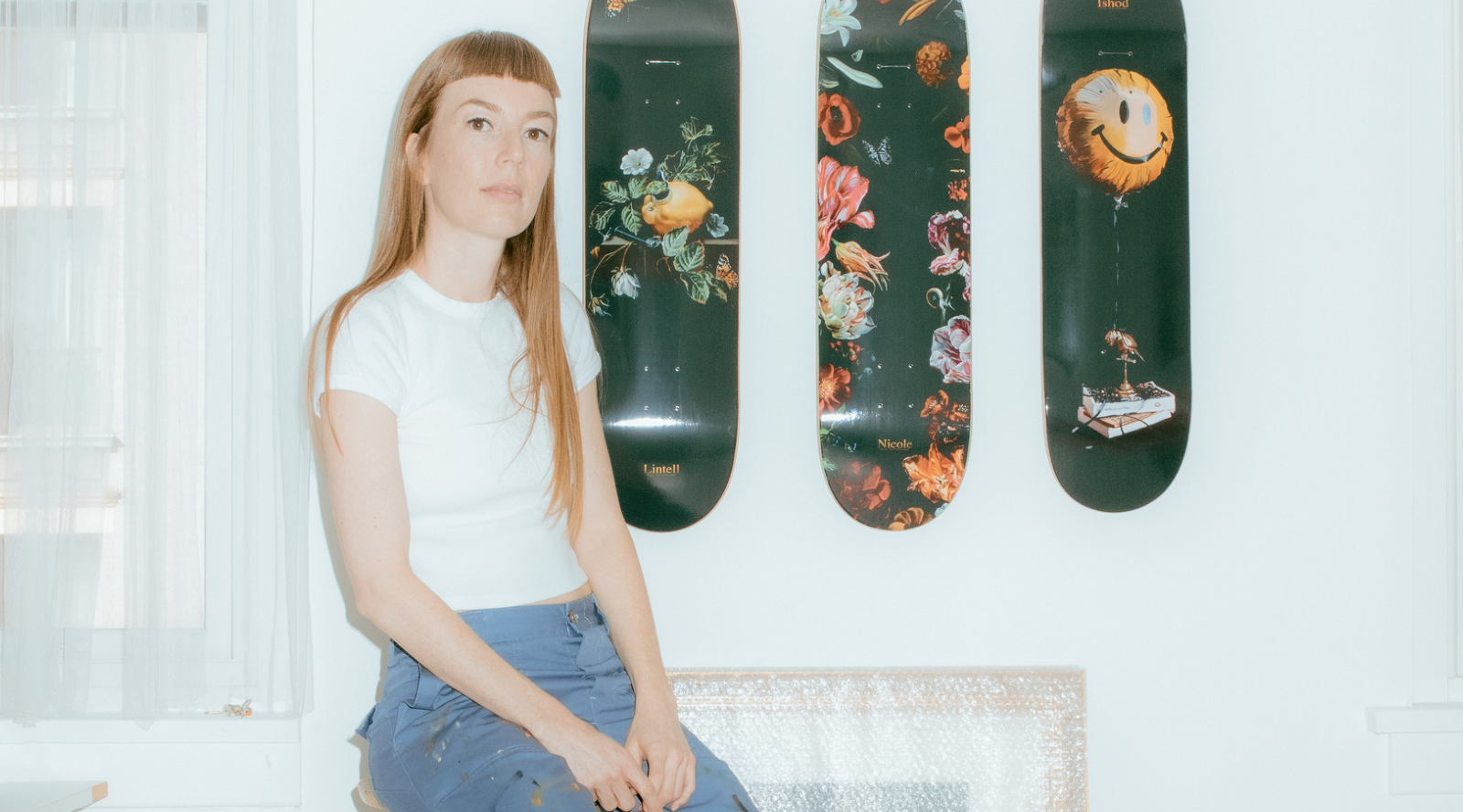Only a few can visualize the words seductive, humorous, lavish, and grim within a singular frame, and Kathy Ager is one of them. The 43-year-old Canadian painter takes great influence from Baroque paintings — precisely, the 17th-Century Golden Age of Dutch and Spanish painting, as well as touches of modern life and pop culture. While Ager’s visual language might be niche to some, the painter has collaborated with multiple brands, including Nike, Polo Ralph Lauren, NOCTA, and more.
Known for her meticulous attention to detail, much of Ager’s innate talent can be credited to her observant nature. Whether people or places that catch the painter’s interest at any given time, Ager’s artwork becomes an extension of personal souvenirs while touching upon universal sentiments that others can relate to.

“When there’s something I want to paint about, I usually start noticing things that might convey these feelings in a tangible way,” Ager tells Beyond The Pines. “Sometimes I might be working on a painting for years in my head before it all comes together.” The artist goes on to detail that once an idea is cemented of what she wants to say and how she plans to visualize it, she’ll move on to sketching, a process that usually includes pulling references from online, photographing objects or photoshopping images together. “I also like to have the title of the painting figured out before I start painting, as it usually ties in elements of humor and additional meaning that are so important to me,” she says to round out her process.

Ahead, Beyond The Pines catches up with Canada native, delving into Ager’s personal inspirations, interests and artistic style.
BEYOND THE PINES: What fascinates you the most about the Baroque style?
Kathy Ager: “I love the beauty and drama of Baroque style paintings. Even the most mundane subject, like a bundle of asparagus, becomes something to behold with the right light and composition. At the same time, there’s a moodiness or darkness to them that I can relate to. My paintings are all about feelings, and it’s comforting to see other people have been seeing that side of things and life for hundreds of years.”
BTP: What’s your favorite part about painting still-life resembling imagery rather than maybe taking a photograph? What got you into it?
KA: “What first got me into painting was how close it got you to the subject. I loved observing every detail, color and contrast. With color, nothing is ever exactly what you think it is. Concrete is never just gray, a banana is never just yellow. When I first started painting, my technique was more loose, so it wasn’t quite so realistic. It was more about nailing those colors. Over the years, my skills have tightened up and have now become closer to realism, but it wasn’t my original intent!”
BTP: Your work often revolves around themes of decay and mortality. What draws you to explore these subjects?
KA: I’ve always been a sensitive person, and because of this and things I experienced as a child, I’ve been struck by the sadness and precariousness of life. For most of my life, I kept these feelings to myself — maybe because we’ve lived in a time of toxic positivity for so long. But my paintings became a way to express those feelings and experiences in a way that seems to resonate with many viewers. Initially, I was creating them just for myself, without an external audience in mind, but since becoming more known as an artist, it’s been amazing to find out so many people can relate to or are drawn to these themes.”

BTP: There’s a varnish of dark humor that casts over your work. Can you tell us about this?
KA: Even more than mortality and decay, I love a good laugh! For me, a painting idea isn’t ready if there isn’t a layer of humor in it. It’s a way of adding a little extra zing to something that would otherwise just be a downer. My true character isn’t as dark as my paintings might suggest, and I like to be reminded of that in my work. If I can take something painful and turn it around into something beautiful, then add a good laugh at the end, I feel I’m back in my power. And that makes me feel strong enough to move on and keep going.”
BTP: Your artwork operates as a visual diary that depicts past art techniques, moments of pop culture, and perhaps personal details. How did you reach a point of merging these themes together?
KA: “When I first started painting, I was mostly just copying photos that I liked, either that I’d taken or that I saw online, for my own entertainment. I didn’t know what I wanted to say, but I knew I liked to paint. At one point, I painted a photo of a still life, and was struck by how much of a story could be told just by combining objects and light. The first few times I created my own still lifes, in the paintings “Lonely Hearts Club” and “Can’t Get High Enough,” I was expressing feelings of loneliness and loss (which I didn’t know how to express at the time) using the objects around me. I liked how using objects that were personal to me, but also recognizable to the viewer made my pieces more striking and relatable to the viewer. In terms of past painting techniques, I initially painted my subjects lit by light coming through my Amsterdam apartment window, against a black background, to make it easier on myself — a more complicated set-up and background would have taken longer to figure out and paint. But it turned out to match the baroque style of painting, and once I noticed that, I really leaned into that style.”
BTP: You’ve once mentioned that your show, the Golden Age, is named as a wordplay to reflect on the art history period and our current obsession with excess. Could you tell me more about that?
KA: “My style is influenced a lot by the Dutch and Spanish Golden Ages of painting, around the 16th and 17th centuries. That title also seems to summarize this peak of consumerism and excess we’re in. I think humans have always had somewhat of an attachment to objects, but it’s been ramping up more and more over time.
BTP: Speaking of excess and consumerism, do you think objects can tell us about who we are, or have a profound personal meaning?
KA: “I think it’s natural to feel an attachment to things around us. We’re sentimental beings, and we want to feel like we have something to hold on to when life can feel precarious. We’re also social creatures, and I like how objects that are universally recognized and their value or meaning understood by many can be used to tell a story that’s both personal to me, and communicates something to the viewer who’s likely a total stranger to me. It’s a way to feel connected to and understood.”


Leave a Reply